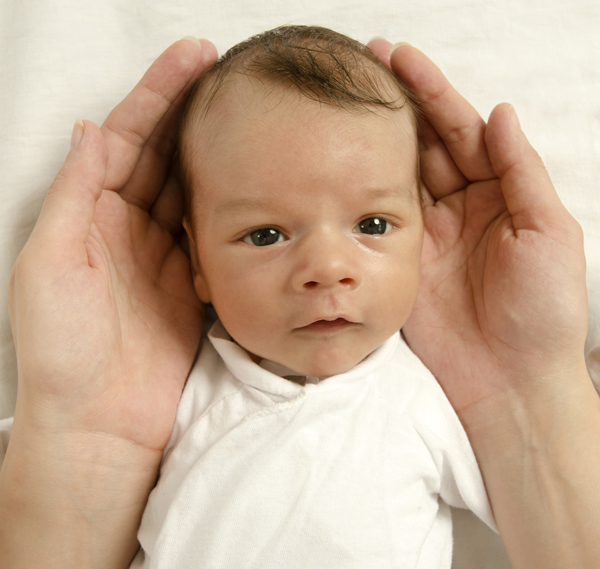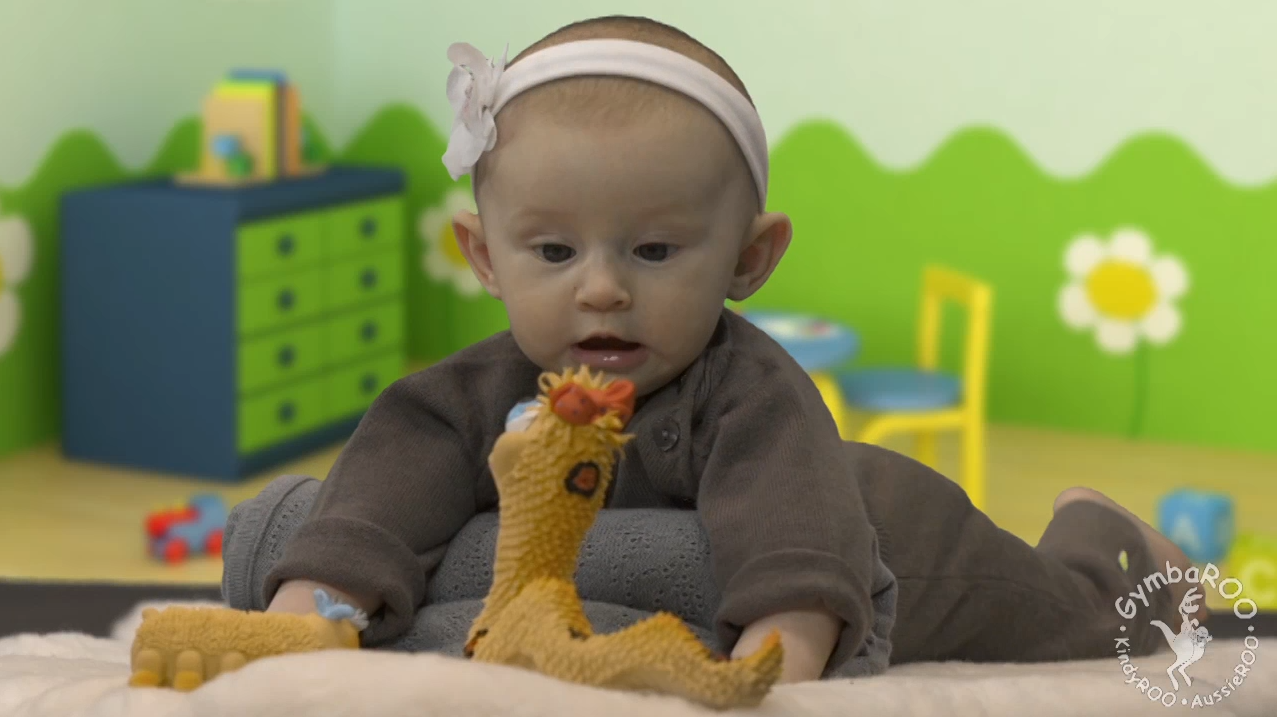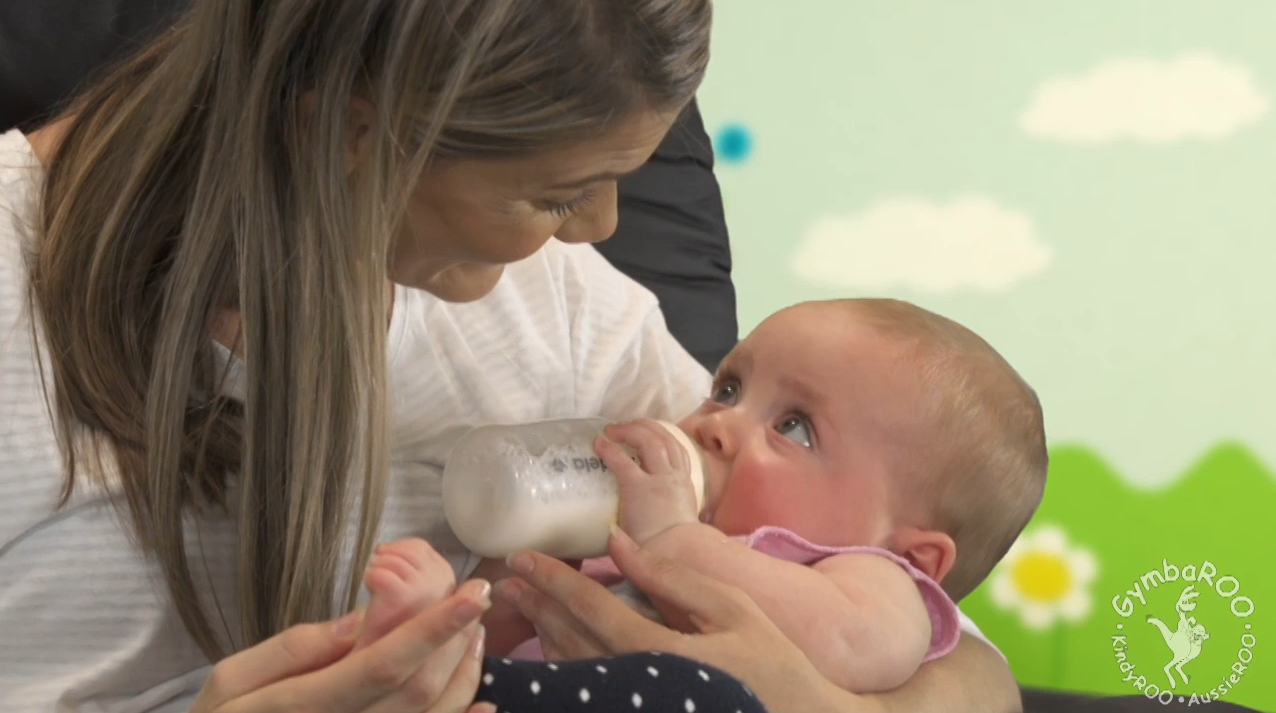Join the thousands of parents already raising smarter, happier babies with our online baby classes: The Active Babies Smart Kids series. Click here.
GymbaROO-KindyROO kids are excelling academically, emotionally, in leadership roles and on the sporting field. Find us at: GymbaROO-KindyROO
Amy Leung: M Phty (Paed), Grad Cert Phty (Paed), PD Phty.
Since 1992, paediatric professionals have been promoting the ‘Back to Sleep’ campaign to reduce the risk of Sudden Infant Death Syndrome (SIDS). Research has shown that over the years this campaign has resulted in a significant reduction in SIDS cases which is awesome. However, this change of sleeping position has, unfortunately, increased the numbers of babies presenting with heads that ‘look out of shape’ due to a flat spot developing on the back or the side. Plagiocephaly is the term given for a flat spot on one side of the back of the head, while brachycephaly occurs in the middle portion of the back of the head. Sometimes plagiocephaly and brachycephaly can co-exist. To distinguish from other causes of a flattened head shape, positional plagiocephaly (PP) and positional brachycephaly (PB) are discussed in this article.
 Newborn babies commonly show a preference for keeping their heads in certain positions. Since they spend most of the time asleep on their backs, their heads are exposed to prolonged pressure on the part that is in contact with the supporting surface. Persistent external forces pressing on the soft and malleable skull bones can flatten the skull. The flat spot is easily noticeable when viewed from the top of the baby’s head. Usually it is obvious when the baby is about six to eight weeks of age. For PP, it is common to have uneven facial features and ear position. For PB, the facial features are symmetrical. Some babies are born with a flat spot on the head due to the position in the womb. These babies are more likely to stay lying on the flat spot and the flattening will become worse.
Newborn babies commonly show a preference for keeping their heads in certain positions. Since they spend most of the time asleep on their backs, their heads are exposed to prolonged pressure on the part that is in contact with the supporting surface. Persistent external forces pressing on the soft and malleable skull bones can flatten the skull. The flat spot is easily noticeable when viewed from the top of the baby’s head. Usually it is obvious when the baby is about six to eight weeks of age. For PP, it is common to have uneven facial features and ear position. For PB, the facial features are symmetrical. Some babies are born with a flat spot on the head due to the position in the womb. These babies are more likely to stay lying on the flat spot and the flattening will become worse.
It is believed that natural correction occurs when the baby develops better head control and mobility at about three months of age. However, full correction may not be obtained and the asymmetry may be persisted into late childhood, especially in severe cases. Studies have shown that less severe cases are reported if early physiotherapy intervention is given. Treatment of PP and PB includes re-positioning in young babies. Helmet therapy can be considered for those moderate to severe cases for babies older than four months. Correctional surgery is not recommended. The general concern of these flattened head shapes is mainly cosmetic, however, there has been lack of research to study the impact of PP or PB on a child’s self image and psycho-social development. In addition, preliminary studies have shown differences in visual, auditory and psycho-motor parameters in children with PP compared to the general population. Further investigations are needed to verify these differences.
Have a listen to paediatrician Dr Meredith talking about PP and PB on GymbaROO-KindyROO’s free online video here: Active Babies Smart Kids: Video 1 Tummy Time
Access the 12 online baby classes here: Active Babies Smart Kids
There are several important positioning strategies that can be adopted to prevent flat spots from developing in young babies
Play Time: It is important to vary the babies’ play position. This can avoid prolong pressure on one spot of the head and provide opportunities for babies to strengthen their muscles and balance. Babies love to play and interact with you, so their play is fun and supervised.
Supervised tummy play time: Tummy play position is crucial for a baby’s development. The best time to do this is before a feed, after a nap or a bath or when the baby is ready to play. This can be started from birth. Commonly, newborns are suitable to have short but frequent tummy play time. Babies at about two months of age should be able to tolerate 10 – 15 minutes, at least 3-4 times each day. For more information on tummy time and lots of activities to do from birth click here: GymbaROO’s free tummy time video.
When putting a baby on the tummy it is important to bring the arms slightly forward and prop on the elbows. This makes it easier for the baby to raise his/her head. For younger babies, putting them on an inclined surface will take away some of the effect of gravity on their heads. The inclined surface can be your chest, a wedge, a triangular pillow, a rolled up towel or a gym ball. This elevated tummy play position is more comfortable for babies with reflux.
If the baby cries or becomes distressed while they are on their tummy:
- Try for shorter periods of time but more often.
- Distract the baby’s attention by your interaction or using toys.
- Do not leave an upset baby in any position.
Laying on the side: Besides tummy position, put babies on their side to play. By alternating the side, the baby will experience different spatial orientation and also prevent prolong pressure on the head.
Alternating the side while playing: It is important to change the position of toys that baby likes to look at or play with. This will encourage the baby to turn his/her head to either side.
Sleep time: Babies spend many hours sleeping in the early months. The head position during sleep is an important factor for the development of PP or PB. Points to note are as follow:
- Continue to put baby to sleep on the back as SIDS recommendation.
- Put baby to sleep on the side is not a strategy to prevent PP or PB.
- Alternate the baby’s position at either end of the cot because baby tends to turn the head to stimulations such as light source, door, parents bed etc…
- Alternate the baby’s head to one side when you put the baby down to sleep. You may use the slogan “Right morning, Left afternoon” as a reminder.
Day to day care
Position of baby in relation to stimulations: If you are using baby positioning equipment be aware of baby’s position in relation to the light source, TV, doorway and family activities. A baby will tend to turn his/her head to these stimulations. Remember to change the position of the baby equipment regularly, so the baby is encouraged to turn the head to either side.
Carrying position: Most of us have a dominant hand therefore we will carry and nurse the baby with our preferred hand or arm. The baby may develop preference when he/she turns the head to one side. Alternating the arm or hand when carrying or nursing your baby will prevent the development of head orientation preference.
Feeding: For those babies who are breast fed, they are already alternating the head position during feeding. However, for those babies who are bottle fed, the carer should alternate the arm for every feed.
Despite the implementation of the above strategies, if you notice that your baby still has a strong preference to turn the head to one side or has a flat spot on the head, you should seek advice from your paediatrician, family doctor, child health nurse or paediatric physiotherapist.
References: Bialocerkowski AE, Vladusic SL and Howell SM (2005). Conservative interventions for positional plagiocephaly: a systematic review. Devel Med & Child Neuro, 47: 563-570. van Vlimmeren LA, van der Graaf Y, Boere-Boomekamp MM, L’Hoir MP, Helders PJ and Engelbert RH (2008). Effect of pediatric physical therapy in children with positional preference. Arch Pediatr Adolesc Med, 162: 712-718.
Amy is a paediatric physiotherapist and holds a Masters Degree in Paediatric Physiotherapy Studies. She has more than twenty years of experience in the field and has particular interest in orthopaedic and developmental paediatrics.
Active Babies Smart Kids – Online Baby Classes
GymbaROO-KindyROO’s online series of baby classes is taking the parenting world by storm! It is highly recommended by doctors, paediatricians, early childhood experts and the Maternal Child and Family Health Nurses Association. This series is being called: “The essential guide for parents”. Join the thousands of parents already playing with their babies from birth, in the best way for brain and body development and laying crucial foundations for future learning. What happens in the first year, not only matters, it matters a lot!
Active Babies Smart Kids online baby classes – Click here.
Try the first class FREE! Click here to watch our Active Babies Smart Kids Episode 1 – Tummy Time
GymbaROO-KindyROO
Thousands of parents, babies and children are presently involved in our programs and creating rising stars. GymbaROO-KindyROO kids are excelling academically, emotionally, in leadership roles and on the sporting field. Come join all the fun and learning! “GymbaROO – The best decision I ever made for my child.” Classes from 6 weeks old – 7 years GymbaROO KindyROO
Enjoy the following GymbaROO-KindyROO articles
GymbaROO-KindyROO: Who, what, where, why and how
All about GymbaROO-KindyROO’s online baby classes for parents and babies: Active Babies Smart Kids
How to raise a smarter, happier baby
Why active babies make smart kids
Become a GymbaROO-KindyROO franchisee
Tummy time for baby’s healthy development.
Beware over use of ‘containers’ – Why babies need the space and freedom to move.
An important warning for all parents of babies.
Baby milestones: A journey, not a race.
10 ways to give your baby a great start.
Overstimulation. Is your baby at risk of sensory overload?
Please do not sit me until I can do it myself.
‘Baby Seat’ devices and propping your baby to sit. Please avoid.
Bare feet for babies: Catching colds, trimming toenails and tips for first shoes.
Gift giving guide for babies: Developmentally brilliant gifts.
Click here for more GymbaROO-KindyROO article choices



